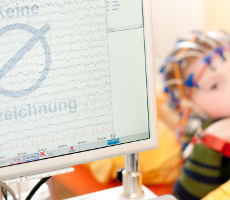Electroencephalogram (EEG)
Author: PD Dr. med. Gesche Tallen, Reviewer: Prof. Dr. med. Ursula Creutzig, English Translation: Hannah McRae, Last modification: 2015/04/28 https://kinderkrebsinfo.de/doi/e30774
An electroencephalogram (EEG) determines the electrical activity of the brain. Fluctuations in voltage of different brain waves are recorded by electrodes placed on the scalp. These fluctuations originate from the electrical impulses caused by communication between brain cells. They present as wavy lines on the EEG monitor.
An EEG helps the doctor to detect abnormal wavy patterns. These are usually analysed by specialists (paediatric neurologists), who may get hints on the underlying brain dysfunction. Abnormal waves can be caused by a brain tumour, represent epilepsy or neurologic side effects of a treatment.
Performing an EEG does not hurt.

